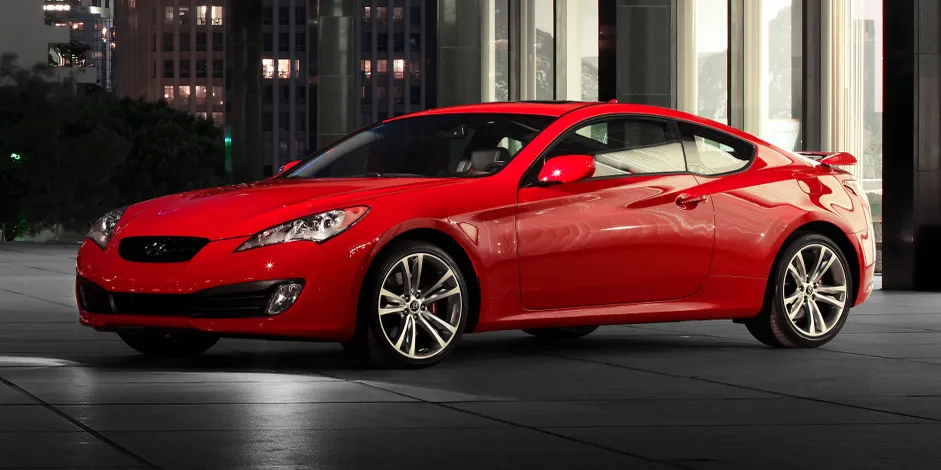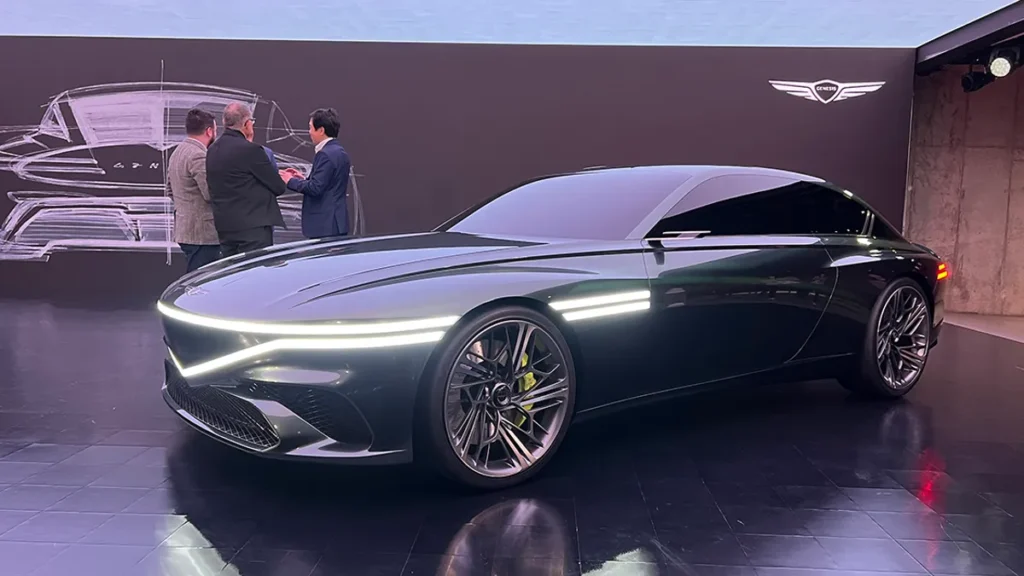
The Genesis Sports Coupe (also known as the Hyundai Genesis Coupe) holds a special place in the evolution of Korean automotive design and engineering. It marked Hyundai’s ambitious entry into the performance and sports car market, demonstrating the automaker’s ability to create vehicles that could compete with established brands like Nissan, BMW, and Ford in the high-performance segment.
Launched in 2008, the Genesis Coupe was the first rear-wheel-drive sports car from Hyundai and was part of the automaker’s larger effort to elevate its brand through the introduction of more premium models. This article explores the story behind the creation of the Genesis Sports Coupe, the design process, and the people who brought this dynamic car to life.
1. The Genesis of the Genesis Coupe: Hyundai’s Bold Vision
The journey of the Genesis Sports Coupe began in the early 2000s when Hyundai started to shift its focus from being a budget car manufacturer to a global brand known for quality, innovation, and performance. Hyundai had already experienced significant success with its affordable sedans and compacts, but the company wanted to make a statement in the sports car market—a highly competitive and aspirational segment dominated by Japanese, European, and American manufacturers.
a) Building on the Genesis Sedan Platform:
Hyundai’s foray into the luxury and sports segments began with the Genesis Sedan, a premium vehicle designed to compete with luxury cars like the BMW 5 Series and Mercedes-Benz E-Class. The success of the Genesis Sedan gave Hyundai the confidence to explore a performance-oriented coupe that would appeal to driving enthusiasts.
The Genesis Coupe shared its rear-wheel-drive platform with the Genesis Sedan, but it was designed to be a driver’s car from the ground up. Hyundai wanted to create a car that not only offered the comfort and features that the Genesis brand was known for but also delivered thrilling performance, precise handling, and bold design.
2. The Design Process: A Global Effort
The design of the Genesis Sports Coupe was a truly global effort, with contributions from Hyundai’s design studios around the world, including its centers in South Korea, the United States, and Europe. The company brought together some of the industry’s most talented designers and engineers to ensure that the Genesis Coupe would stand out in the crowded sports car market.
a) Phil Zak: Hyundai’s North American Design Chief:
One of the key figures in the design of the Genesis Coupe was Phil Zak, who at the time was the Chief Designer at Hyundai’s California Design Studio. Zak played a critical role in shaping the Genesis Coupe’s bold, muscular exterior. Before joining Hyundai, Zak had worked at General Motors, where he contributed to the design of performance-oriented models like the Chevrolet Camaro and Pontiac GTO.
Zak’s experience with American muscle cars influenced the Genesis Coupe’s design, which features aggressive lines, a wide stance, and a distinctive front grille. His vision was to create a car that looked fast even when standing still—a car that would appeal to young, performance-oriented buyers who wanted a sporty, powerful vehicle with a striking appearance.
b) Joel Piaskowski: Another Visionary Behind the Coupe:
Another influential figure in the design of the Genesis Coupe was Joel Piaskowski, who was also part of Hyundai’s California Design Studio. Piaskowski had previously worked at Mercedes-Benz and Ford, and his design philosophy centered around blending style with performance.
Piaskowski’s work on the Genesis Coupe emphasized the balance between aesthetics and aerodynamics. He wanted the car to not only look great but also perform efficiently. His team focused on elements such as the coupe’s sculpted sides, rear diffuser, and sporty proportions, all of which contributed to the car’s sleek yet aggressive look.
c) SangYup Lee: Leading Hyundai’s Modern Design Language:
Although SangYup Lee wasn’t directly involved in the Genesis Coupe’s original design, his contributions to Hyundai’s overall design direction in the years following its release are worth noting. Lee, who had a background working for Bentley and GM, later became instrumental in defining the design identity of the Genesis luxury brand.
While Lee’s influence came later, his philosophy of creating vehicles that balance luxury and performance aligns closely with the Genesis Coupe’s objectives. Today, SangYup Lee continues to push Hyundai and Genesis design forward, focusing on bold designs that captivate both luxury buyers and performance enthusiasts.
3. Design Highlights of the Genesis Coupe
The Genesis Coupe’s design was intentionally bold, aggressive, and dynamic. Hyundai wanted to break away from the conservative designs that had characterized some of its earlier models, aiming for something that would grab attention both on the road and at the dealership.
a) Exterior Design:
The exterior design of the Genesis Coupe was one of its most striking features. The front end featured a low-slung hood, wide stance, and Hyundai’s signature hexagonal grille, giving the car a distinctive and aggressive appearance. The large headlights, which swept back into the fenders, added to the car’s aerodynamic look.
On the sides, the coupe had strong character lines that ran from the front fender to the rear quarter panels, creating a sense of movement and speed. The coupe’s rear was equally impressive, with dual exhaust tips and a diffuser-like element that emphasized the car’s performance credentials.
The overall proportions were balanced and purposeful, with a long hood and short rear deck, reminiscent of classic sports coupes. The Genesis Coupe’s design language was meant to evoke speed and power, making it a head-turner on the road.
b) Interior Design:
The interior of the Genesis Coupe was driver-focused, with a cockpit-like layout that placed the emphasis on the driving experience. The materials used were a mix of soft-touch plastics, aluminum accents, and leather, giving the cabin a premium feel without sacrificing the car’s sporty nature.
The instrument cluster featured large, easy-to-read gauges, and the center stack was angled slightly toward the driver, reinforcing the car’s performance-oriented nature. Despite being a performance coupe, the Genesis Coupe also offered practical features such as a spacious trunk and rear seats, making it a relatively practical choice for a sports car.
4. Performance and Engineering: More Than Just Looks
The Genesis Coupe was not just about looks—it was engineered to perform. It offered a choice of two engines: a 2.0-liter turbocharged inline-four and a 3.8-liter V6. The turbocharged four-cylinder was aimed at buyers who wanted an affordable yet sporty driving experience, while the V6 was designed to compete with cars like the Nissan 370Z and Ford Mustang.
a) Rear-Wheel-Drive Platform:
One of the key selling points of the Genesis Coupe was its rear-wheel-drive (RWD) platform. While many affordable sports cars in the same price range featured front-wheel drive, the Genesis Coupe’s RWD layout provided a more authentic sports car experience, offering better handling dynamics, balance, and the ability to drift—something driving enthusiasts appreciated.
b) Handling and Suspension:
The suspension setup was also tuned for performance, with independent multi-link suspension in the rear and a MacPherson strut front setup. Hyundai’s engineers worked hard to ensure that the Genesis Coupe delivered precise and responsive handling, making it a favorite among tuners and track enthusiasts.
5. The Genesis Coupe’s Legacy
Although production of the Genesis Coupe ended in 2016, its impact on Hyundai’s brand and reputation cannot be overstated. It was a bold experiment that helped Hyundai prove that it could compete in the performance and sports car market, a segment typically dominated by Japanese and American automakers. The Genesis Coupe also paved the way for Hyundai’s luxury division, Genesis, which has since become a standalone brand known for producing luxury sedans, SUVs, and electric vehicles that rival the best in the industry.
a) Influence on Genesis Brand:
While the Genesis Coupe itself was discontinued, the lessons Hyundai learned from its development and marketing have been applied to the broader Genesis brand. Today, Genesis is a premium marque that competes with luxury brands like BMW, Lexus, and Audi. The sporty DNA of the Genesis Coupe lives on in models like the Genesis G70, a performance-oriented luxury sedan, and the Genesis X Concept, a preview of a future luxury sports coupe.
Conclusion
The story of the Genesis Sports Coupe is one of innovation, bold design, and a commitment to challenging industry norms. Designed by a global team of experts, the Genesis Coupe brought together the best elements of Korean engineering and international design expertise. It not only introduced Hyundai to the world of performance cars but also helped lay the foundation for the successful Genesis luxury brand.
With its rear-wheel-drive layout, powerful engines, and aggressive styling, the Genesis Coupe became a favorite among driving enthusiasts and paved the way for Hyundai’s continued success in the performance and luxury segments. Today, the spirit of the Genesis Coupe lives on in the cars produced under the Genesis brand, a testament to the vision and creativity of its designers and engineers.
